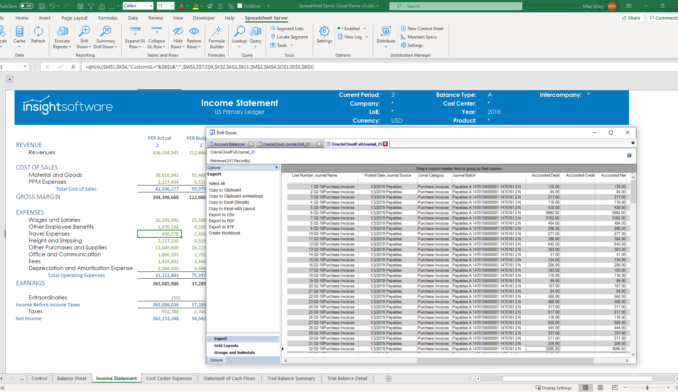Bridging the Gap Between IT and Finance to Accelerate Reporting

There is often a communication gap between the technology experts in the IT department and the accounting experts in the finance department, especially when it comes to designing or modifying financial reports. Each department speaks its own “language,” and it’s all too easy for details to get lost in translation.
Unfortunately, that lack of understanding can have ramifications for the overall effectiveness of an organization. Finance personnel may explain what they want from IT, only to get something that’s very different from what they expected. The resulting re-work wastes time and resources and causes unnecessary delays. Finger-pointing and organizational friction are frequent byproducts of this cycle.
It doesn’t need to be that way. With some patience and effort on both sides of those departmental boundaries, it is possible not only to get reports right on the first attempt, but also to empower workers throughout the organization to get what they need, when they need it, all without headaches and needless delays.
This is increasingly important as the volume and velocity of reporting requirements continue to expand. Even with a good understanding of what finance wants, at some point, an IT department may find itself unable to provide customized reports as quickly as they are needed by the finance department.
Ideally, IT can better meet the needs of finance by concentrating on providing a platform that enables finance to create its own reports in a way that is easy, while still honoring ERP security and ensuring that users cannot “break” the system by creating runaway queries.
To that end, IT professionals should be asking questions that shed light on finance’s overall reporting needs with a view toward providing finance with self-service solutions that allow finance professionals to create reports safely and easily, without technical training.
The Translation Problem
The root cause of miscommunication is the gap in understanding across the domains of IT and finance. Technology is complex. IT staff must have the deep expertise required to sort out data storage and access, data integrity, performance, and all of the other technical factors in the reporting and analytics domain. IT experts don’t have a finance background, so they don’t necessarily understand the nuances of inventory valuation methods, GL account segmentation, or accrual basis accounting.
Finance professionals, on the other hand, must master accounting standards, financial statements, performance ratios, and the functional aspects of the ERP system. However, it’s rare to find a person in finance who understands things like data access APIs, SQL syntax, database security, or integration technology.
How can these two groups begin to communicate more effectively about financial reporting and analytics? It starts with asking deeper questions about the stated requirements, and probing further to understand why they need certain information, as well as when and how often it’s required, and how it fits into the big picture for finance and accounting.
Consider this example: A midsized company has just implemented a new ERP system, and the purchasing manager has asked the IT department to design an inventory report that matches the report that he used to get from the old system. In cases like this, IT should ask for details. Which information are you using? How important is this column, or that one? Do you really need all this detail, or would a summary of each category be better?
In many cases, this kind of inquiry will yield interesting results. Sometimes, a good deal of the information on the report is unnecessary; no one ever uses it. This example comes from a real-world case in which over half of the information on the report turned out to be unnecessary. The request was to provide a report that looks just like the old one; but in this particular case, that did not match the user’s actual needs.
There is presumably a cost and a benefit to every project. The problem in the case of financial reporting is that IT understands the cost (that is, the complexity and effort required to get the job done), while finance knows what benefit they are looking for (that is, what they are ultimately trying to accomplish with a particular report).
In the example cited above, finance had expressed their requirements far too broadly, resulting in a specification that asked for considerably more work than was actually required. In other cases, however, finance might fail to request what they need because they aren’t aware of what is possible. They may begin with a baseline assumption about what can be done, not knowing that IT might be able to deliver reports that make their lives substantially easier.
What, Why, When, and Who?
IT teams need to ask the what, why, when, and who questions in order to get to the bottom of what finance actually needs. They should dig deeper to gain a better understanding of what finance is trying to accomplish, and how they use reporting to get there. This means continuing to ask “why?”.
In a best case scenario, IT and finance will sit down to walk through the process. Why are you asking for this report? What do you do with the information? What other information might it also be useful to have? When and how often do you repeat this process?
By developing a deeper understanding of “a day in the life” of finance, IT professionals can deliver better results while saving time by avoiding re-work. Modern principles of design advocate getting to know how an end-user thinks and acts, and what they care about. While it might be a tall order for someone in the IT department to become an accounting expert, it is certainly possible to develop a deeper understanding of how finance works. That requires a lot of work from both IT and finance, but it pays good dividends in the long term.
When the finance team asks for a new report or modification to an existing one, IT needs to understand whether there is an ongoing reporting need behind that request, or whether there are one or more ad hoc information requirements that finance is trying to address.
When Congress passed the CARES Act in March of 2020, organizations around the United States scrambled to gather the information necessary to complete loan applications under the Paycheck Protection Program (PPP). Later, when it came time to apply for PPP loan forgiveness, finance teams needed to pull together information about payroll and occupancy expenses. That was (hopefully) a one-time process; in other words, it was an ad hoc reporting requirement.
Similarly, it is common in most organizations for executive management to ask one-off questions about something that is happening in the business. “What are our costs for outside consultants, and in what functional areas?”, “How much are we spending on printing and copying, and could we save money with the new vendor contract?”. These kinds of questions typically indicate an ad hoc requirement.
Depending on the specific scenario, the most cost-effective approach for ad hoc reports might be to manually assemble the required information. After all, it doesn’t make sense to invest a lot of time in developing a report that finance will only use once.
The reverse is also true. In many cases, finance is bogged down with manual processes that they perform over and over again. By replacing those tedious cut-and-paste or export/import processes with automated reporting, IT can deliver tremendous value to the finance department, saving substantial time and effort on an ongoing basis. That can’t necessarily happen without a deeper understanding of how the finance team works. With a clear view of roles, responsibilities, and capabilities across the finance and IT departments, the technology experts will be able to deliver higher value with less effort.
Helping Finance Understand Technology
The quest for better communication cuts both ways. IT should strive not only to understand the needs of finance and accounting more thoroughly, but also to help the finance team to better understand the technical capabilities of the organization and its systems. This helps to mitigate some of the frustration that people feel when they can’t easily get information they want. It can also help the finance team understand what is possible and what is not. That, in turn, results in better communication of reporting requirements.
Business reporting and analytics have come a long way in the past decade. At the same time, new challenges have emerged as software has moved to the cloud, and as security and data access have grown in complexity.
Cloud-based software presents some unique challenges because there can be limits to data access. Oracle’s ERP cloud, for example, caps datasets at 25,000 rows. In some systems, there are restrictions on the number of API calls that you can make to retrieve data.
Some vendors are also restricting direct database access in an effort to tighten security. In Microsoft Dynamics 365 Finance & Supply Chain Management (D365 F&SCM), for example, Microsoft has implemented a data abstraction layer consisting of “data entities”, which serve as a kind of intermediary to get to the ERP data. Unless you have the right reporting tools, this can add significantly to IT’s workload.
The Merits of Self-Service Reporting
You remember that old saying about giving a man a fish versus teaching him how to catch a fish? The ideal scenario is one in which finance can create and modify reports without outside help. IT has a critical role to play in selecting, implementing, and supporting the tools that will help finance to be more self-sufficient.
When the finance and accounting team has the capability to design, develop, and modify reports without the direct assistance of IT, both departments win. IT can focus on higher value activities and strategic projects, while finance can get exactly what they need, without delay.
insightsoftware offers a range of purpose-built solutions that cater to the needs of both finance and IT. By managing data access and ERP connectivity, IT can be sure of data integrity and security. Finance teams can reduce their dependence on direct IT involvement and improve the results they get from reporting and analytics.
To find out more about how insightsoftware can help your organization improve reporting and analytics, contact us for a free demo.








